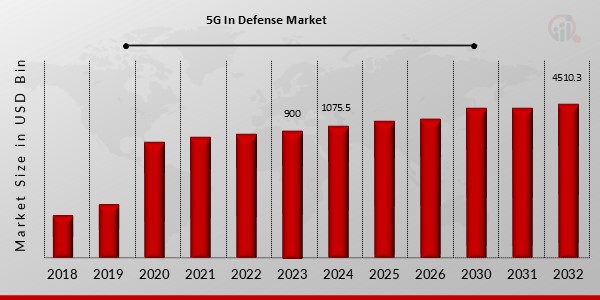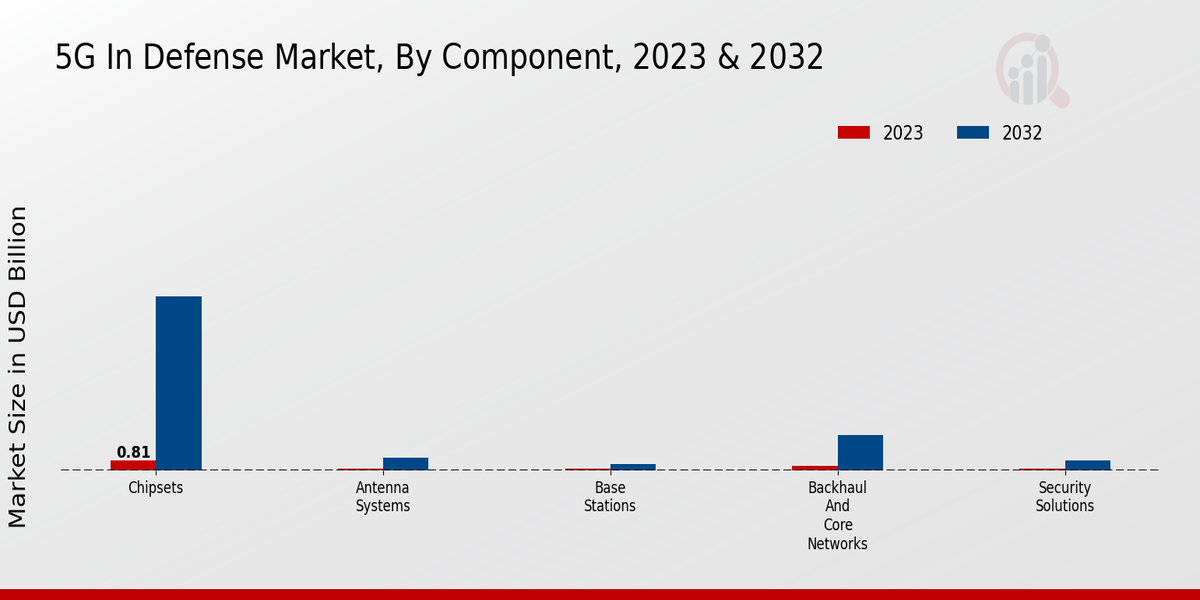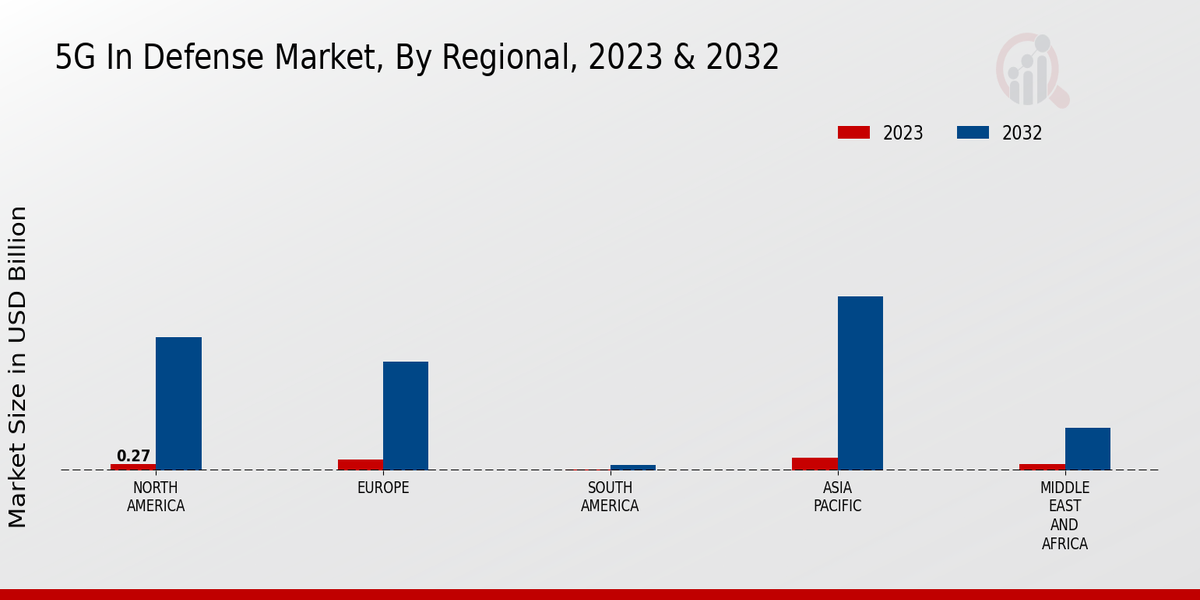Global 5G In Defense Market Overview
5G In Defense Market Size was estimated at 900 (USD Billion) in 2023.The 5G In Defense Market Industry is expected to grow from 1075.5 (USD Billion) in 2024 to 4510.3 (USD Billion) by 2032. The 5G In Defense Market CAGR (growth rate) is expected to be around 19.50% during the forecast period (2024 - 2032).

Source Primary Research, Secondary Research, MRFR Database and Analyst Review
Key 5G In Defense Market Trends Highlighted
The 5G in the Defense market is poised for significant growth, driven by the increasing need for advanced communication and data transmission capabilities in defense operations. Governments worldwide are investing heavily in modernizing their defense systems, recognizing the potential of 5G to enhance situational awareness, facilitate real-time decision-making, and improve overall mission effectiveness. The demand for 5G-enabled technologies is expected to rise due to their ability to support immersive training simulations, remote-controlled systems, and autonomous platforms.
Recent trends in the 5G Defense market include the emergence of private 5G networks dedicated to defense applications, providing secure and reliable connectivity within military bases and operational areas. Additionally, there is a growing emphasis on interoperability and collaboration among different 5G networks, enabling seamless communication and data sharing between allied forces and defense agencies. As governments and militaries seek to gain a competitive edge, the adoption of advanced 5G-based technologies is likely to accelerate in the coming years, shaping the future of defense and national security.
5G In Defense Market Drivers
Rising Adoption of 5G Networks in Defense Applications
There are several reasons why the expansion of 5G networks is a massive driver of the 5G in the Defence Market Industry. Firstly, 5G outperforms previous generations of networks in terms of speed, latency and reliability. Given the variety of Defence applications, including battlefield communication, situational awareness and command and control, such performance has tremendous value. Secondly, governments and militaries around the world are making large investments in 5G infrastructure.As a result, the demand for solutions that would allow Defence organizations to exploit the benefits of the new technology is also set to rise. Thirdly, 5G has several key advantages over previous technologies when it comes to Defence organizations Faster data transmission speeds 5G offers speeds of up to 10 Gbps, which is much greater than the speeds at which previous network generations transmitted data. This feature makes 5G useful for sharing large files, such as video recordings or sensor data, between different points nearly instantaneously. Lower latency 5G networks have been designed to offer a near-instantaneous response. Their latency is below 1 millisecond, which constitutes a substantial improvement on previous network generations. Defense organizations could, therefore, use them to control weapons or vehicles over the distance more effectively. Greater reliability Last but not least, 5G networks are also more reliable, boasting a 99.999% uptime guarantee. This is crucial for Defence applications that would be severely compromised by even a short network downtime.With all of this in mind, it is not surprising that the expansion of 5G networks is a key driver of the 5G in the Defence Market Industry.
Increasing Need for Enhanced Situational Awareness
The need for enhanced situational awareness is another key driver for the growth of the 5G Defense Market Industry. In today's complex and ever-changing battlefield, it is essential for defense organizations to have a clear understanding of their surroundings in order to make informed decisions and take appropriate action. 5G technology can provide defense organizations with a number of tools and capabilities that can help them to improve their situational awareness, including Real-time data collection and analysis 5G networks can be used to collect and analyze data from a variety of sources, including sensors, drones, and satellites.This data can be used to create a real-time picture of the battlefield, which can help defense organizations identify threats, track enemy movements, and make informed decisions. Augmented reality (AR) and virtual reality (VR) 5G networks can be used to support AR and VR applications, which can provide defense organizations with a more immersive and interactive way to view and interact with data. This can help defense organizations to better understand the battlefield and make more informed decisions. Artificial intelligence (AI) 5G networks can be used to support AI applications, which can help defense organizations automate tasks, analyze data, and make predictions. This can help defense organizations to improve their situational awareness and make better decisions.
Growing Government Spending on Defense
Another important driver for the increasing growth of the 5G In Defense Market Industry is the growing government spending on defense. Today, governments all over the world face bigger threats from terrorism, cyberattacks, and other types of security threats and, as a result, invest more cash in national defense in order to protect their people and interests. Thus, the growing government spending is likely to benefit the 5G In Defense Market Industry, as countries are likely to invest in 5G-enabled types of equipment and defense solutions in order to enhance military power.
5G In Defense Market Segment Insights
5G In Defense Market Component Insights
The component segment of the 5G Defense Market is anticipated to grow significantly over the forecast period due to the rise in demand for 5G-based defense systems. The 5G technology provides numerous advantages over the previous generations, including ultra-reliable, low-latency communication and high network density, which is ideal for a broad range of military applications. Chipset is the key component of any 5G device and the market for 5G chipsets is expected to grow substantially over the forecast period. The increase in the adoption of 5G smartphones and other devices is driving the growth of this market.Antenna system is another component of 5G networks, the market for antenna systems is also anticipated to grow significantly over the forecast years. The increase in demand for 5G base stations and other infrastructures is likely to drive the growth of this market as well. The base station is required for providing 5G coverage, and the market for base-station is expected to grow substantially over the forecast years. The increase in demand for 5G services and the need to expand the coverage area are likely to drive the growth of this market. Backhaul and core networks are another crucial component of the 5G networks; the market for backhaul and core networks is expected to grow substantially over the forecast period.The increased demand for 5G services and the need to upgrade existing networks for accommodating 5G traffic are drivers of this market.

Source Primary Research, Secondary Research, MRFR Database and Analyst Review
5G In Defense Market Platform Insights
The Platform segment of the 5G Defense Market is anticipated to witness significant growth in the coming years. Land-based platforms are projected to dominate the segment, driven by the increasing need for mobile and agile communication systems for ground forces. Airborne Platforms are also expected to gain traction as they provide enhanced situational awareness and real-time intelligence-gathering capabilities. Maritime Platforms, with their ability to support both coastal and deep-sea operations, are anticipated to contribute to the segment's growth.Space-Based Platforms, leveraging their coverage and secure communication capabilities, are expected to play a crucial role in the future of defense communications. Overall, the Platform segment is poised for substantial growth, driven by the increasing adoption of 5G technology and its transformative impact on defense operations.
5G In Defense Market Application Insights
The Application segment of the 5G in Defense Market is categorized into Situational Awareness and Intelligence, Command and Control, Communications and Networking, Fire Control and Targeting, and Logistics and Supply Chain Management. Among these, the Communications and Networking segment held the largest market share in 2023 and is expected to maintain its dominance throughout the forecast period. The growth of this segment can be attributed to the increasing need for secure and reliable communication networks in defense operations. The Situational Awareness and Intelligence segment is expected to register the highest CAGR during the forecast period, owing to the growing adoption of 5G-enabled technologies for real-time situational awareness and intelligence gathering.
5G In Defense Market Regional Insights
The 5G In Defense Market is segmented into North America, Europe, APAC, South America, and MEA. North America held the largest market share in 2023 and is expected to continue its dominance throughout the forecast period. The region's early adoption of 5G technology and the presence of major defense contractors contribute to its leading position. Europe is another significant market driven by government initiatives to modernize defense systems and the increasing demand for advanced communication and surveillance capabilities. APAC is projected to witness substantial growth due to rising defense spending in countries like China and India.South America and MEA are expected to experience moderate growth, with potential opportunities emerging in Brazil and Saudi Arabia.

Source Primary Research, Secondary Research, MRFR Database and Analyst Review
5G In Defense Market Key Players And Competitive Insights
In the 5G In Defense Market's highly competitive industry environment, the major players are focusing on research and development activities to enhance their product portfolio and to gain a competitive advantage. 5G In Defense Market is characterized by investments in advanced technologies to upgrade the solutions' efficiency and functionality. Among the major factors of the 5G In Defense Market development are the companies’ adoption of partnerships and collaborations to enhance their market presence and revenue share. Product development strategies and technological advancements are the major forces influencing the 5G In Defense Market development.
Nokia. Among the major 5G In Defense Market players is Nokia, the company specializing in the development of 5G In Defense Market tailored solutions. Its product portfolio incorporates a range of 5G products, such as private LTE/5G networks, mission-critical push-to-talk solutions, and network management systems. Nokia's partnerships with the U.S. Department of Defense, U.S. Air Force, and other U.S. government agencies and defense contractors focused on the delivery of such solutions. These products facilitate situational awareness, communication, and tactical operations in the most challenging environments. The customer-oriented approach focused on technological and R D investments defined Nokia's leading position in the 5G in Defense Market.
Lockheed Martin. Lockheed Martin is a major 5G In Defense Market player offering a wide range of integrated solutions based on 5G technology for defense market targeting. Its product portfolio encompasses communication systems, cyber defense solutions, and intelligence, surveillance, and reconnaissance technologies, among others. Lockheed Martin, having broad experience in aerospace, defense, and IT industries, implements a partnership approach with different stakeholders for efficient solutions, products and service development. The customers of Lockheed Martin benefits are mainly government and defense agencies.
Key Companies in the 5G In Defense Market Include
- General Dynamics
- Lockheed Martin
- Airbus
- Boeing
- Northrop Grumman
- Nokia
- Raytheon Technologies
- Leonardo S.p.A.
- BAE Systems
- Thales Group
- L3Harris Technologies
- Samsung
- SAAB
- Ericsson
- Huawei
5G In Defense Market Industry Developments
Notable developments in the 5G in Defense Market include increased adoption of 5G networks by defense forces worldwide, strategic partnerships between industry leaders, and government initiatives to enhance defense capabilities through 5G integration. Recent events, such as geopolitical tensions and military conflicts, have highlighted the need for advanced communication and surveillance technologies, driving demand for 5G solutions in defense applications. Key players are investing in research and development to provide innovative solutions, such as secure networks, edge computing, and artificial intelligence-powered systems, to meet the evolving needs of defense organizations.
5G In Defense Market Segmentation Insights
- 5G In Defense Market Component Outlook
- Chipsets
- Antenna Systems
- Base Stations
- Backhaul and Core Networks
- Security Solutions
- 5G In Defense Market Platform Outlook
- Land-Based Platforms
- Airborne Platforms
- Maritime Platforms
- Space-Based Platforms
- 5G In Defense Market Application Outlook
- Situational Awareness and Intelligence
- Command and Control
- Communications and Networking
- Fire Control and Targeting
- Logistics and Supply Chain Management
- 5G In Defense Market Regional Outlook
- North America
- Europe
- South America
- Asia-Pacific
- Middle East and Africa
| Report Attribute/Metric |
Details |
| Market Size 2023 |
900(USD Billion) |
| Market Size 2024 |
1075.5(USD Billion) |
| Market Size 2032 |
4510.3(USD Billion) |
| Compound Annual Growth Rate (CAGR) |
19.50% (2024 - 2032) |
| Report Coverage |
Revenue Forecast, Competitive Landscape, Growth Factors, and Trends |
| Base Year |
2023 |
| Market Forecast Period |
2024 - 2032 |
| Historical Data |
2019 - 2022 |
| Market Forecast Units |
USD Billion |
| Key Companies Profiled |
General Dynamics, Lockheed Martin, Airbus, Boeing, Northrop Grumman, Nokia, Raytheon Technologies, Leonardo S.p.A., BAE Systems, Thales Group, L3Harris Technologies, Samsung, SAAB, Ericsson, Huawei |
| Segments Covered |
Component, Platform, Application, Regional |
| Key Market Opportunities |
1 Enhanced situational awareness2 Improved communication and collaboration3 Increased precision and effectiveness4 Accelerated deployment and responsiveness5 Enhanced security and protection |
| Key Market Dynamics |
Rising demand for secure and resilient communication networks Increasing adoption of 5Genabled devices and sensors Government initiatives and funding for 5G defense applications Advancements in artificial intelligence and machine learning technologies Growing need for real-time intelligence and situational awareness |
| Countries Covered |
North America, Europe, APAC, South America, MEA |
Frequently Asked Questions (FAQ) :
The 5G In Defense Market is expected to reach an overall valuation of 1.57 USD Billion by 2023, with a projected CAGR of 33.06% between 2024 and 2032, resulting in a market size of 20.5 USD Billion by 2032.
North America is projected to dominate the 5G in Defense Market due to the presence of major defense contractors and government initiatives supporting 5G technology adoption. Additionally, the region's focus on military modernization and technological advancements is expected to drive market growth.
The key growth drivers of the 5G In Defense Market include increasing demand for enhanced situational awareness, improved communication capabilities, and real-time data processing in defense applications. Additionally, government initiatives to modernize defense systems and the growing adoption of 5G networks are expected to drive market growth.
5G technology finds various applications in the defense sector, including secure communication systems, remote surveillance, unmanned aerial vehicles (UAVs), and command and control systems. It enables faster data transmission, low latency, and improved connectivity, enhancing the efficiency and effectiveness of defense operations.
Major players in the 5G in Defense Market include Lockheed Martin, Northrop Grumman, BAE Systems, Raytheon Technologies, and SAAB. These companies offer a range of 5G-enabled defense solutions, including communication systems, radar systems, and electronic warfare systems.
The 5G In Defense Market faces challenges such as cybersecurity concerns, spectrum availability, and cost considerations. Ensuring the security of 5G networks and data is crucial for defense applications, and the availability of sufficient spectrum is essential for supporting high-bandwidth 5G operations. Additionally, the cost of deploying and maintaining 5G infrastructure can be a limiting factor.
Emerging trends in the 5G in Defense Market include the integration of artificial intelligence (AI) and machine learning (ML) into 5G-enabled defense systems, the adoption of edge computing for real-time data processing, and the development of 5G-based autonomous systems. These advancements are expected to enhance the capabilities and effectiveness of 5G technology in defense applications.
5G technology is expected to revolutionize military operations by enabling real-time data sharing, enhanced situational awareness, and improved coordination between different units. It will facilitate the use of advanced technologies such as augmented reality (AR) and virtual reality (VR) for training and simulation, as well as support the development of autonomous systems and swarm technologies.
5G technology offers significant benefits for defense applications, including faster and more reliable communication, improved data processing capabilities, and enhanced connectivity. It enables the real-time transmission of large amounts of data, facilitating better decision-making and faster response times. Additionally, 5G supports the development of new technologies, such as unmanned systems and artificial intelligence, which can further enhance defense capabilities.
5G technology is currently being used in various defense applications, including secure communication systems, remote surveillance, and unmanned aerial vehicles (UAVs). It is also being explored for use in command and control systems, situational awareness systems, and training and simulation applications. As 5G networks become more widely available, their adoption in defense applications is expected to grow significantly.

















